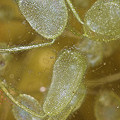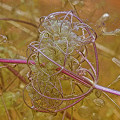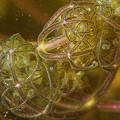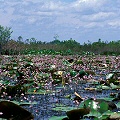| Utricularia section Vesiculina | ||
|---|---|---|
| Species | Range | Habit1 |
| U. cucullata | South America | SA |
| U. myriocista | South America | SA |
| U. purpurea | North and Central America | SA |
| 1SA=suspended aquatic. | ||
Q: About Utricularia subgenus Utricularia section Vesiculina
A: This section is characterised by the interesting fact that the leaves occur on the
stolon in wheel-like (i.e., verticillate) groups. Also, the traps are always terminal on the leaf segments. In fact, I tend to
think of these plants as not having leaves at all---only bladders. The plants are so interesting that Lloyd felt that if you
wanted to pull the plants in section Polypompholyx into a separate genus, you certainly should
do so for the same for the plants in section Vesiculina.
The first two species in my listing are very variable in floral characteristics, and I
would not be surprised if further studies were to split them into more species.
Molecular work suggests that this section might not be monophylletic--watch for it possibly being broken up in the future.
Utricularia myriocista
The big daddy of this group, the flowers are up to 3.5 cm long, on
an inflorescence that becomes fat and spongy at its base. Some of the forms have been given names like
Utricularia pulcherimma or Utricularia magnifica, which translate to
extremely beautiful or magnificent. Wow! The inflorescences are densely covered with glandular hairs that capture insects.
Hmm, that sounds suspicious!
Utricularia purpurea
Because of its common occurrence in North America, this is the species
that most people are familiar with. Although it has such interesting bladders, overall structure, and flowers, it is difficult to
maintain in collections since it seems to decompose almost instantly if the conditions are not right. In fact, the plant sometimes
does not even survive the few days it takes to ship them from one grower to the next.
There is some research suggesting that this species is no longer carnivorous, and instead uses its traps to house algae that
provide the plant with valuable nutrients. However, in around 1876 Mary Treat
studied the enzymatic digestion of prey in this species.
Interestingly, plants in the wild sometimes have a transluscent, purplish quality
that reminds me more of saprophytic plants than photosynthesizing ones.
This wide ranging species occurs in a large area in Canada, Ontario on eastwards.
In the USA it is found in a wide range along the entire eastern seaboard and also the Great Lakes area.
Elsewhere it occurs in the
Bahamas, Cuba, Jamaica, Belize, and Costa Rica.
Page citations: Lloyd, F.E. 1942; Müller, K.F. et al. 2006; Rice, B.A. 2006a;
Richards, J.H. 2001;
Taylor, P. 1989; personal observations.



